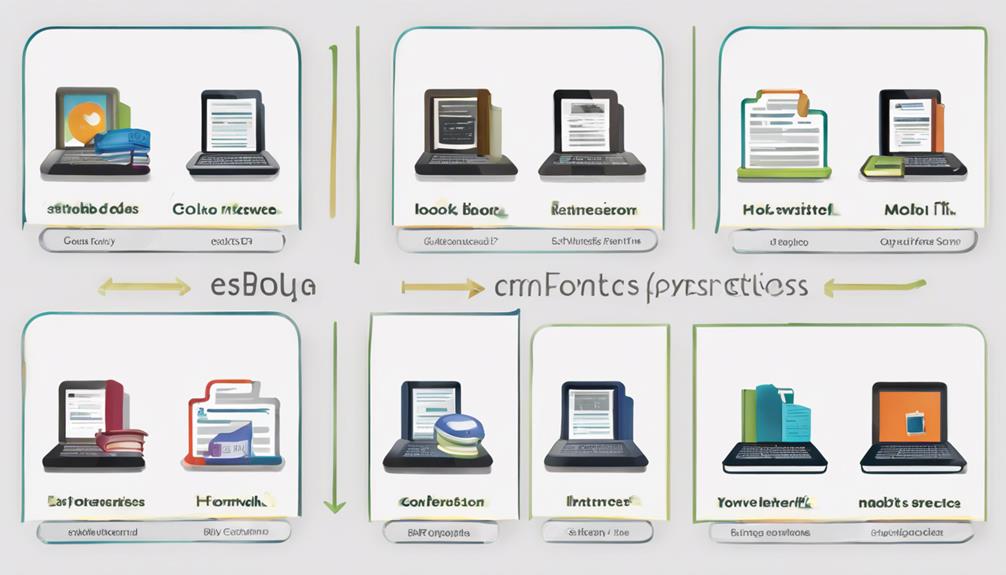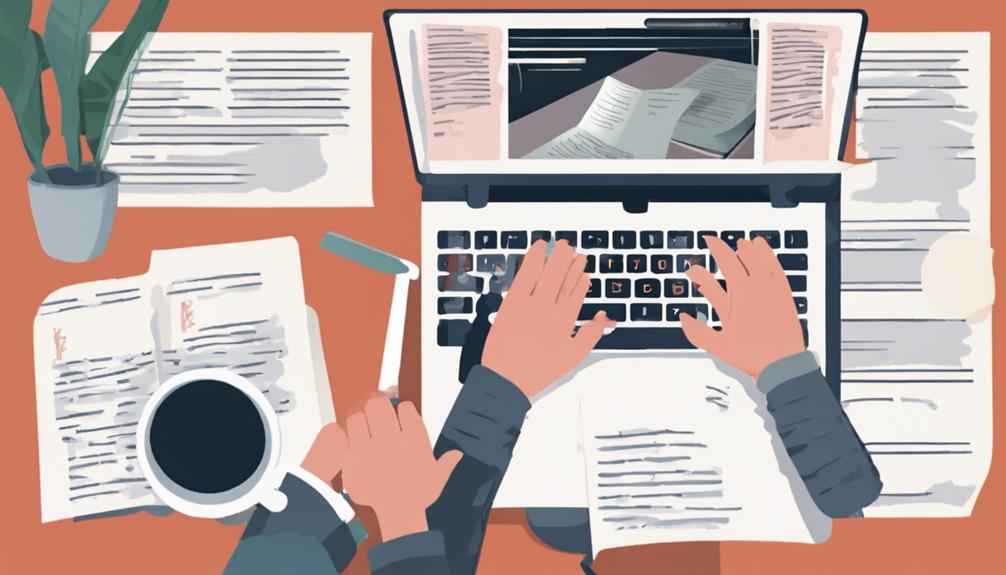If you’re concerned about the time and effort required to transform your textbook into a digital format, rest assured that with the right approach, the process can be streamlined and effective. By following a systematic method, you can ensure a smooth transition that preserves the integrity of your content while enhancing its accessibility and engagement. Starting with the initial steps of choosing a reliable conversion service and preparing your materials, you’ll embark on a journey that not only digitizes your textbook but also opens up new possibilities for interaction and user experience enhancement.
Choose a Book Conversion Service
When looking to digitize your textbooks, the first step is to choose a reliable book conversion service. To start, consider the conversion options offered by different services. Some may provide enhanced features like interactive elements or multimedia integration. Pricing comparison is crucial as rates can vary based on the complexity of your textbooks and the level of customization needed. Look for services that offer transparent pricing structures to avoid any hidden costs.
Quality assurance is key when selecting a book conversion service. Ensure that the service guarantees accurate digitization without compromising the content or formatting of your textbooks. Customer reviews are an excellent way to gauge the reliability and satisfaction levels of past clients. Check for feedback on the service’s responsiveness, adherence to deadlines, and overall quality of the digital textbooks produced.
Prepare Your Textbook
Before starting the conversion process, gather all necessary materials such as the physical textbook, any accompanying materials, and relevant resources. Organize the content effectively by creating a clear outline or table of contents to help streamline the digitization process. By preparing your textbook thoughtfully, you can ensure a smoother transition into its digital format.
Gather Necessary Materials
To digitize your textbook effectively, you must first gather all the necessary materials required for this transformation. Begin by ensuring you have access to high-quality scanning equipment that can accurately capture the text and images from your textbook. Familiarize yourself with different scanning techniques such as flatbed scanning or sheet-fed scanning to determine the best method for your specific textbook.
Additionally, it is crucial to consider copyright considerations and fair use when digitizing your textbook. Make sure you have the necessary permissions to reproduce any copyrighted material within your textbook. If you are unsure about the legality of digitizing certain content, seek guidance from your institution’s legal department or consult with a copyright expert.
Organize Content Effectively
Organizing the content of your digitized textbook effectively is essential for creating a user-friendly and accessible digital resource. To achieve this, consider implementing a clear visual hierarchy and well-defined content structure. Utilize headings, subheadings, and bullet points to break down information into digestible chunks, making it easier for users to navigate through the material. By organizing your content in a logical and intuitive manner, you can enhance the overall user experience and ensure that readers can easily locate the information they need.
Incorporating interactive elements such as clickable links, multimedia content, and quizzes can further engage users and make the learning experience more dynamic. These interactive elements not only add value to your digital textbook but also help reinforce key concepts and boost user engagement. Remember to test the functionality of interactive features to ensure they work seamlessly on various devices.
Decide on the Digital Format
When deciding on the digital format for your textbook, make sure to choose a suitable format that caters to the content and layout of the material. Additionally, consider the accessibility needs of your audience, ensuring that the digital version is user-friendly and inclusive for all readers. By selecting the right format and prioritizing accessibility, you can enhance the overall reading experience and reach a broader audience with your digital textbook.
Choose Suitable Format
Consider the various digital formats available when deciding how to transform textbooks into a digital format. When choosing a suitable format, focus on the design layout and multimedia components.
For the design layout, think about how you want the content to be presented digitally. Some formats, like PDFs, maintain the original layout of the textbook, while others offer more interactive and customizable options. Interactive formats like EPUB or HTML allow for dynamic content that can enhance the learning experience.
Incorporating multimedia elements is also crucial. Choose a format that supports videos, images, audio files, and interactive elements to make the digital textbook engaging and informative. Embedding multimedia can help clarify complex concepts, provide real-world examples, and cater to different learning styles.
Consider the needs of your audience and the goals of the digital textbook when selecting a format. By prioritizing design layout and multimedia integration, you can create a digital textbook that is engaging, accessible, and effective in conveying information.
Consider Accessibility Needs
To ensure the digital textbook you are creating meets the needs of all learners, including those with disabilities, it is vital to consider accessibility requirements when deciding on the digital format. User testing is crucial in this process. By conducting user testing with individuals who have different types of disabilities, you can gather valuable feedback on the usability and accessibility of the digital textbook. This feedback can help you make necessary adjustments to enhance the overall user experience for all students.
Additionally, when choosing a digital format, it is important to consider assistive technology. Different digital formats may interact differently with various assistive technologies such as screen readers, magnification software, or speech-to-text tools. Ensuring compatibility with common assistive technologies will make the digital textbook more accessible to students with disabilities. By taking these factors into account during the decision-making process, you can create a digital textbook that is inclusive and accessible to all learners.
Submit Your Textbook for Conversion
Ready to take the next step in digitalizing your textbook? To submit your textbook for conversion, ensure it meets formatting requirements for a smooth transition. The conversion process involves converting your physical textbook into a digital format, including text, images, and interactive elements. Timeframe expectations can vary depending on the complexity of your textbook, but a rough estimate can be provided by the conversion service. Consider cost considerations before submitting your textbook for conversion, as prices may vary based on the size and complexity of the textbook. It’s essential to get a clear understanding of the costs involved before proceeding. Once you’ve gathered all the necessary information, you can confidently submit your textbook for conversion. Be prepared to provide all the required materials and information to expedite the process. Now that you’re ready to move forward, the next step will be reviewing the converted file to ensure it meets your expectations.
Review the Converted File
Upon receiving the converted file of your textbook, it is crucial to promptly review its contents to ensure accuracy and quality. Start by checking if all the text, images, and formatting elements have been accurately transferred. Verify that the file sharing process has not resulted in any missing or distorted content. Evaluate the user experience by navigating through the document to ensure easy access to different sections.
Next, focus on the interactive features that have been incorporated into the digital format. Check for elements like clickable links, multimedia content, quizzes, or interactive diagrams that enhance reader engagement. Ensure that these features function correctly and add value to the learning experience.
Make Necessary Revisions
After reviewing the converted file of your textbook, you may find the need to make necessary revisions to enhance its overall quality and effectiveness. Updating content is essential in transforming your textbook into a digital format. Here are some key areas to focus on:
- Correcting Errors: Ensure all spelling, grammar, and factual errors are rectified to maintain credibility.
- Adding Multimedia Elements: Enhance engagement by incorporating videos, images, and interactive elements.
- Improving Navigation: Make sure the digital version is easy to navigate with clear headings, subheadings, and a user-friendly interface.
- Updating References: Verify the accuracy and relevance of all references and ensure they are up to date.
- Enhancing Interactivity: Include quizzes, interactive exercises, and links to external resources to make learning more engaging.
Frequently Asked Questions
Can I Convert a Textbook With Heavy Graphics and Images?
You can convert a textbook with heavy graphics and images by utilizing image compression and OCR technology. Optimize for graphic-heavy content and ensure digital preservation. This process streamlines your content for digital consumption without losing quality.
Is It Possible to Preserve the Original Formatting During Conversion?
Yes, you can maintain the original formatting during conversion, but there may be limitations. Preserving intricate textbook graphics poses challenges. Ensure a seamless transition, balancing fidelity with digital adaptability for optimal results.
How Long Does the Conversion Process Typically Take?
Imagine a digital metamorphosis unfolding before your eyes. The conversion process typically takes around 2-4 weeks, balancing cost considerations with time management. Compatibility issues may arise, but ensuring a seamless user experience is paramount.
Are There Any Restrictions on the Size of the Textbook for Conversion?
When converting a textbook to digital format, you may encounter file size limitations and formatting restrictions. Make sure your textbook meets these requirements to ensure a smooth transformation process that maintains quality and accessibility.
Can I Request Additional Features Like Interactive Elements Post-Conversion?
You can definitely request additional features like interactive elements post-conversion. Enhancing user engagement through multimedia integration can make the digital textbook more dynamic and engaging for learners, enriching their educational experience with interactive content.



